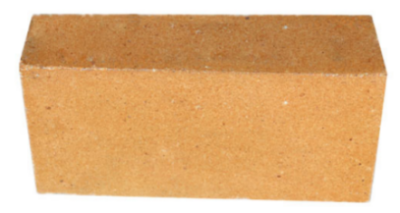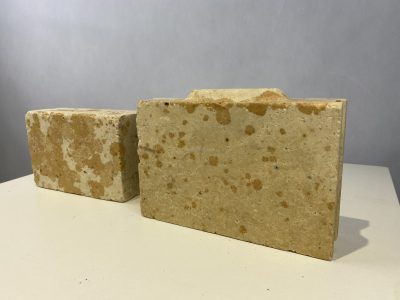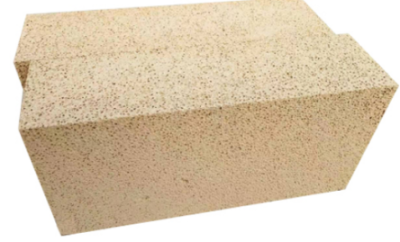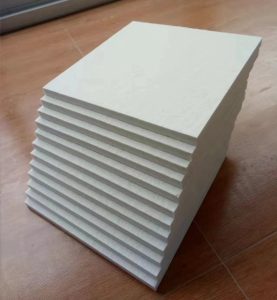In the construction of glass melting kiln, light insulation brick plays a vital role. They can not only effectively reduce heat loss, but also maintain a stable temperature in the melting kiln, thus ensuring the quality and efficiency of glass melting. So, what are the types of lightweight insulation bricks commonly used in glass melting kilns?
PART 01

The production of lightweight clay bricks first involves a precise ratio of raw materials. The material is usually made from a fine mixture of clay, clinker, and additives such as hardwood chips. Clay as the main raw material, its content is about 30% to 40%, providing the basic shape and fire resistance of the product. The addition of clinker, accounting for 15% to 25%, enhances the strength of the product. The hard wood chips, accounting for up to 30% to 45%, will burn to form pores during the firing process, thereby reducing the density of the product and achieving the effect of “light”.In the production process, specific additives such as syrups and sulfite pulp waste are added in order to improve the plasticity and stability of the mud. Then, after careful mixing, trapping and forming, a rigorous drying process is carried out to ensure that the residual moisture is less than 10%, which is crucial for the subsequent firing and the final quality of the product.The firing process is a key link in the production of lightweight clay bricks, which needs to be carried out at a high temperature of 1250 ~ 1350 ° C and kept warm for 4 hours to ensure that the chemical reaction inside the material is complete and the expected physical and chemical properties are achieved.In addition, lightweight clay bricks can also be made by mixing with porous or hollow materials such as fly ash beads, diatomaceous earth, etc., which further reduces the weight of the material while maintaining good thermal insulation properties.In the characteristics of lightweight clay bricks, its bulk density is between 0.4 and 1.3g/cm³, which makes it widely used in industrial furnaces and other occasions requiring thermal insulation. At the same time, lightweight clay bricks may need to be shaped after firing to ensure the accuracy and consistency of the product.
PART 02

The preparation of lightweight silicon bricks requires delicate operation and strict control of raw materials. First of all, the selected ordinary silica needs to be finely ground to ensure that its particle size is below 1mm. A specific proportion of anthracite or coal coke is then added, and the particle size of these additions is also precisely controlled to form the ideal porous structure during firing, thereby reducing the density of the material.In addition, a small amount of lime, gypsum and pulp waste are added to the raw material, which play a key auxiliary role in the forming and firing process. After precise dosing, mixing, shaping and drying, lightweight silicon bricks are fired at temperatures between 1270 and 1300 ° C.The characteristics of lightweight silicon bricks are also very prominent. Its bulk density is controlled in 0.9 ~ 1.1g/cm³, which makes it lightweight and can effectively reduce the structural load in applications. At the same time, its thermal conductivity is only half that of ordinary silicon bricks, showing excellent thermal insulation performance. It is worth mentioning that the load softening starting temperature of light silicon brick is as high as 1600℃, which makes it have a wide range of application prospects in the high-temperature industrial field.
PART 03
Lightweight high aluminum brick

The production of lightweight high-aluminum bricks must first select raw materials, mainly high-aluminum clinker and clay, and subtly add a small amount of sawdust to adjust the consistency of the blank. In order to maintain the stability of the mud, electrolytes such as Al2(SO4)3 are also added during the production process. The addition of a foam agent with low surface tension is to form a stable and evenly distributed foam mud, which is a key step to ensure that the lightweight high aluminum brick has an ideal porosity structure.During the forming stage, foam mud is injected into the model by the pouring method, and the uniformity and stability of the green billet is ensured by precisely controlling the temperature and time during the drying process. Especially after the initial drying at low temperature, it is then dried at high temperature to further remove the residual water and prepare for the subsequent firing process.The firing link is the core part of the manufacture of lightweight high-aluminum bricks, which needs to be carried out at a high temperature of 1300 ~ 1350 ° C and kept warm for 4 ~ 6 hours.The bulk density of lightweight high aluminum bricks is controlled in the range of 0.4 to 1.0g/cm³, which gives them a significant advantage in reducing structural load. At the same time, the porosity of up to 66% to 67% not only reduces the thermal conductivity of the material, but also enhances the thermal insulation effect. These characteristics make lightweight high-alumina bricks widely used in thermal insulation, lining and other applications requiring fire insulation in high-temperature industrial kilns.
PART 04
Lightweight thermal insulation board and thermal insulation foam

Thermal insulation cotton, especially ceramic fiber board, as an efficient thermal insulation material, plays a key role in the thermal insulation design of glass kiln.
① Characteristics of ceramic fiber board
Light weight and high strength: Ceramic fiberboard has a low density, so it is light weight and easy to install and maintain. At the same time, it has a high strength, can withstand a certain mechanical pressure and thermal stress.
Low thermal conductivity: The thermal conductivity of ceramic fiber board is very low, which means that it can effectively prevent the transfer of heat and provide good thermal insulation effect.
Small heat capacity: The small heat capacity of the material means that it is able to quickly absorb and release heat, which contributes to the rapid adjustment and stability of the temperature in the kiln.
Corrosion resistance and oxidation resistance: Ceramic fiber board has good corrosion resistance and oxidation resistance, and can maintain long-term stability in high temperature and corrosive environment.
②The application advantages of ceramic fiber board in glass kiln
Maintain the sealing of the kiln: ceramic fiber board can be used as the backing insulation board of the kiln, and its excellent sealing performance helps to reduce the heat loss in the kiln and improve energy efficiency.
Improved insulation: Due to the extremely low thermal conductivity of ceramic fiber board, it can significantly reduce the heat loss of the kiln, thereby maintaining the stability of the temperature in the kiln, which is essential for glass melting and quality improvement.
Prolong the life of the kiln: By reducing temperature fluctuations and thermal stress inside the kiln, ceramic fiber boards help reduce damage to the kiln material, thereby extending the overall life of the kiln.
Energy conservation and environmental protection: The optimized insulation design not only reduces energy consumption, but also reduces exhaust emissions, in line with the current social needs of energy conservation and environmental protection.
In addition to the above common lightweight insulation bricks, there are many other types of lightweight insulation materials on the market to choose from. With the continuous progress of science and technology and the emergence of new materials, we believe that there will be more efficient and environmentally friendly lightweight insulation bricks in the future, providing more high-quality solutions for the energy saving and efficient production of glass melting kilns.
